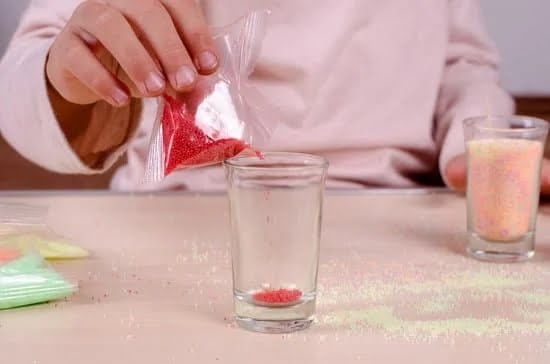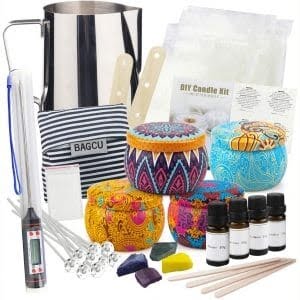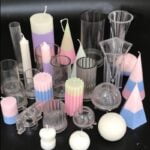When it comes to making candles, one of the most crucial decisions you will need to make is choosing the right wick. The type of wick you use can greatly impact the overall burn performance and quality of your candles.
So, what do you use as a wick when making candles? In this comprehensive article, we will delve into the world of candle wicks, exploring the different types available and providing tips on selecting the perfect wick for your specific needs.
A candle wick serves as the pathway for the flame, allowing for a consistent and efficient burn of wax. Choosing the correct wick based on factors such as candle size, wax type, and fragrance load is vital in achieving a clean and even burn throughout your candle’s lifespan. With so many options available in terms of material and size, understanding the different types of candle wicks can be overwhelming.
In this article, we will provide an in-depth overview of the various types of candle wicks, including natural and synthetic options. We will explore their pros and cons for candle making, helping you decide which option is best suited to your desired outcome. Additionally, we will discuss how to choose the perfect wick size based on key factors such as container diameter and wax composition.
By mastering the art of selecting and attaching the perfect wick for your candles, you can ensure a successful burn every time. Join us as we guide you through this essential aspect of candle making and empower you with knowledge that will elevate your craftsmanship to new heights. Get ready to dive into the fascinating world of candle wicks.
Understanding the Different Types of Candle Wicks
When it comes to making candles, understanding the different types of candle wicks is essential. The type of wick you choose will greatly impact the burning and overall performance of your candle. In this comprehensive overview, we will explore the various types of candle wicks available in the market.
- Cotton Wicks: Cotton wicks are one of the most commonly used types of wicks in candle making. They are made from braided or twisted cotton fibers and are known for their clean burn and minimal smoke output. Cotton wicks come in a range of sizes, allowing you to choose the right thickness for your specific candle size and wax type.
- Wooden Wicks: Wooden wicks have gained popularity for their unique crackling sound when burned, reminiscent of a cozy fireplace. These wicks are typically made from sustainable materials like cherry wood or bamboo, and they add a rustic touch to your candles. Wooden wicks work best with soy wax or other natural waxes, creating an aesthetically pleasing burning experience.
- Zinc Core Wicks: Zinc core wicks are another common type used in candle making. These wicks consist of a cotton outer braid with a zinc core running through the center. The zinc core provides additional rigidity to the wick, keeping it upright during burning. This type of wick is often used in container candles as it helps prevent mushrooming and ensures a stable flame.
- Paper/Coreless Wicks: Paper or coreless wicks are popular options for smaller candles such as tea lights or votives. As the name suggests, these wicks do not have a core material and are made entirely from paper fibers. They are easy to use and provide efficient burning for small candles.
- Ribbon/Braid Wicks: Ribbon or braid wicks offer unique visual appeal to your candles due to their flat shape. These types of wicks are useful for creating decorative candles or specific designs where a round wick wouldn’t be suitable. Ribbon wicks come in different widths, allowing you to choose the appropriate size for your candle.
Understanding the different types of candle wicks gives you the flexibility to choose the right one based on your specific needs and preferences. Whether you’re looking for a clean burn, crackling ambiance, or visual appeal, there is a wick type that will suit your requirements. Experimenting with different types of wicks can also add creativity and uniqueness to your candle-making projects.
Natural vs. Synthetic Wicks
When it comes to choosing the right wick for your candles, one important decision to make is whether to use a natural or synthetic wick. Each type has its own set of pros and cons, which can impact the burn quality and overall performance of your candles.
Natural Wicks:
- Cotton Wicks: Made from pure cotton fibers, these wicks are widely used in candle making due to their excellent burn characteristics. They provide a steady flame, even wax consumption, and minimal soot production. Cotton wicks are known for their clean and efficient burning performance.
- Hemp Wicks: Made from hemp fibers, these wicks are an eco-friendly choice for candle makers. They offer a slow-burning flame, ensuring that your candles last longer. Hemp wicks also have a low environmental impact as they are derived from renewable sources.
- Wooden Wicks: These unique wicks offer a rustic and cozy ambiance to your candles with their crackling sound reminiscent of a fireplace. Wooden wicks burn cleanly with less soot residue compared to cotton or hemp alternatives. They also provide a wider melt pool, allowing for better fragrance throw.
Synthetic Wicks:
- Zinc-Core Wicks: These wicks are known for their stability and ability to support larger diameter candles. The zinc-core provides rigidity, preventing the wick from sagging or bending while burning. It also reduces mushrooming and carbon buildup on the tip of the wick.
- Paper-Core Wicks: Made with a paper-based core infused with other materials like cotton or polyester, these wicks offer good rigidity without requiring a metal center core like zinc-core wicks do. Paper-core wicks provide consistent flame height throughout the burn time.
Overall, choosing between natural and synthetic wicks depends on personal preference and the specific requirements of your candle. Natural wicks are often favored for their eco-friendly properties and clean burn, while synthetic wicks offer stability and suitability for larger candles. It is recommended to experiment with different wick types and sizes to find the perfect combination for your candle making projects.
Choosing the Perfect Wick Size for Your Candle
When it comes to making candles, selecting the right wick size is crucial for achieving a successful burn. The size of your wick will directly impact how evenly and efficiently your candle burns, as well as how long it lasts. To ensure you choose the perfect wick size for your candle, there are several factors you should consider.
- Diameter of the Candle Jar: One of the most important factors in determining the right wick size is the diameter of your candle jar or container. The diameter will determine how much heat needs to be generated by the flame to achieve a full melt pool across the surface of the wax. As a general rule, larger diameter candles require larger wicks, while smaller diameter candles need smaller wicks.
- Wax Type and Blend: Different types of wax have varying melting points and behaviors when burned. For example, soy wax tends to have a lower melting point than paraffin wax. It’s crucial to consider your chosen wax type when selecting a wick size as it will affect how effectively heat is transferred through the wax during burning.
- Desired Burn Rate and Scent Throw: The burn rate refers to how quickly or slowly your candle melts and consumes its wax. A larger wick size typically results in a faster burn rate, while a smaller wick size provides a slower burn.
Additionally, if you’re using fragrances in your candles, you’ll want to consider how strong or subtle you want the scent throw to be. A larger wick can help enhance scent throw but may also result in excessive sooting.
To determine the appropriate wick size for your candle, it’s recommended that you consult with reputable candle-making suppliers or reference online resources that provide comprehensive charts and guides based on various jar sizes, wax types, and desired burn rates. Remember that trial and error may be necessary as every combination of factors may yield different results.
By considering these factors and conducting proper research, you can ensure that you choose the perfect wick size for your candle, resulting in a beautifully crafted and long-lasting product.
Finding the Ideal Wick Material for Different Candle Wax Types
Choosing the right wick material is crucial when it comes to making candles. The type of wick material you use can greatly impact the burn quality, fragrance throw, and overall performance of your candle. Different candle wax types require specific wick materials to achieve optimal results. In this section, we will explore a guide to finding the ideal wick material for different candle wax types.
1. Soy Wax:
Soy wax is a popular choice among candle makers due to its natural and eco-friendly characteristics. When using soy wax, it is recommended to use cotton or cotton core wicks. These wicks are known for their clean burning properties and ability to handle the lower melting point of soy wax.
2. Beeswax:
Beeswax is another natural option for candle making that produces a beautiful golden glow and a pleasant honey-like scent. Beeswax requires a thicker and sturdier wick compared to other wax types due to its high density and slower burn rate. Braided cotton or square braided cotton wicks are often recommended for beeswax candles.
3. Paraffin Wax:
Paraffin wax is widely used in commercial candle production due to its affordability and versatility. When working with paraffin wax, you have more options for wick materials. Some commonly used wick materials for paraffin wax include cotton core wicks, paper-core wicks, zinc-core wicks, or even specialty wicks such as crackling wood or ribbon wicks.
4. Coconut Wax:
Coconut wax has gained popularity in recent years as a sustainable alternative to traditional candle making materials. Similar to soy wax, cotton or cotton core wicks are recommended for coconut wax candles. These types of wicks provide an efficient burn while allowing the natural properties of coconut wax to shine through.
| Candle Wax Type | Ideal Wick Material |
|---|---|
| Soy Wax | Cotton or cotton core wicks |
| Beeswax | Braided cotton or square braided cotton wicks |
| Paraffin Wax | Cotton core wicks, paper-core wicks, zinc-core wicks, specialty wicks (crackling wood or ribbon) |
| Coconut Wax | Cotton or cotton core wicks |
It’s important to note that these recommendations are not set in stone and may vary depending on specific candle recipes and individual preferences. Experimenting with different wick materials for each wax type can help you find the perfect combination that suits your desired burn characteristics and aesthetic preferences. Remember to always test your candles before mass production to ensure the chosen wick material performs well with your particular candle wax.
DIY Candle Wick Ideas
When it comes to candle making, there are various alternative options for creating unique and personalized wicks. These DIY candle wick ideas allow crafters to think beyond traditional materials and explore creative alternatives that can add an extra touch of uniqueness to their candles.
One popular option for a DIY candle wick is using wooden wicks. These wicks are made from natural materials like wood and can create a visually appealing crackling sound while burning. Wooden wicks provide a cozy ambiance and are particularly suitable for soy-based candles or candles with strong fragrances.
Another interesting DIY candle wick idea is using cotton string or twine as a wick. This option can give your candle a rustic and charming look, perfect for farmhouse-style or bohemian-themed decor. It’s important to note that cotton string or twine may burn faster compared to traditional wicks, so it’s necessary to experiment with different thicknesses and diameters to achieve the desired burn time.
For those who prefer eco-friendly options, a great alternative is using hemp or hemp-derived twine as a candle wick. Hemp is a sustainable material that has gained popularity in various industries due to its durability and environmentally friendly properties. Using hemp twine as a wick not only adds an interesting visual element but also aligns with sustainable practices.
| Candle Wick Material | Description |
|---|---|
| Wooden Wicks | Made from natural materials like wood, creates crackling sound while burning. |
| Cotton String or Twine | Gives a rustic and charming look; burns faster than traditional wicks. |
| Hemp Twine | An eco-friendly option made from sustainable hemp fibers. |
With these DIY candle wick ideas, candle makers have the opportunity to get creative and experiment with different materials to achieve their desired aesthetic and ambiance. It’s essential to remember that when using alternative wick options, it’s important to ensure they are properly sized and appropriately attached to the container for a safe and successful burn.
Step-by-Step Guide
To ensure that your candle burns correctly and safely, it is crucial to select and attach the perfect wick. This step-by-step guide will walk you through the process of choosing and attaching a suitable wick for your candle.
Step 1: Determine Your Candle Size
The size of your candle plays a significant role in selecting the right wick. Measure the diameter of your container or mold to identify its size accurately. It is essential to match the wick’s diameter with that of your candle for optimal burning.
Step 2: Consider Your Wax Type
Different wax types require different wicks for efficient burning. For example, soy wax typically requires a larger wick compared to paraffin wax. Be sure to consider the specific recommendations for each type of wax to achieve an even and clean burn.
Step 3: Consult Wick Charts
Wick charts are valuable resources that provide suggested wick sizes based on various factors such as container size, wax type, and desired burn time. These guidelines can help narrow down your options and save time in selecting the right wick.
Step 4: Test Your Wicks
Once you have narrowed down your options based on the above considerations, it is important to conduct a test burn with each candidate wick. Cut several pieces of each potential wick size and attach them to your containers or molds using appropriate adhesive or tab assemblies. Light each tester wick one at a time and observe how they perform. Pay attention to factors such as flame height, melt pool formation, hot throw, and overall burn quality.
Step 5: Make Adjustments if Needed
Based on the results of your test burns, you may need to make adjustments in selecting the right wick size or type. If your candle has an excessively large flame, emits excessive smoke, or produces a small melt pool, you may need to consider using a smaller wick.
On the other hand, if the flame is too small, tunneling occurs, or the scent throw is weak, a larger wick may be necessary. Remember to make adjustments and test again until you find the perfect fit for your candle.
By following these step-by-step guidelines, you can select and attach the perfect wick for your candle, ensuring a safe and enjoyable burn every time. Remember that testing and experimentation are key in finding the ideal combination of wick size and type for your specific candle-making needs.
Troubleshooting Common Wick Issues
When it comes to making candles, achieving a successful burn is crucial for creating a high-quality product. However, many candle makers often encounter common wick issues that can affect the performance of their candles. In this section, we will explore some of these common issues and provide helpful tips for troubleshooting them.
One common problem that candle makers may encounter is a wick that produces excessive smoke when lit. This can be caused by several factors, including an improperly sized wick or a poor quality wick material. To troubleshoot this issue, consider using a smaller wick size for your candle and ensure that you are using a high-quality wick made from natural materials such as cotton or hemp.
Another common wick issue is known as “tunneling,” where the wax around the edge of the container does not melt evenly and creates a tunnel down the center. This can happen when the wick used is too small for the diameter of the candle. To solve this problem, try using a larger wick size or consider using multiple smaller wicks spaced evenly across the container to promote more even melting.
Additionally, some candle makers may experience a phenomenon known as “mushrooming,” where carbon deposits accumulate at the tip of the burning wick and create an unsightly black ball or mushroom shape. This can lead to excessive soot and an unpleasant burning smell. To prevent this issue, trim your wicks to about ¼ inch before each use and avoid over-stuffing your candles with fragrance oils or additives that can contribute to mushrooming.
By being aware of these common wick issues and implementing proper troubleshooting techniques, you can ensure a successful burn for your homemade candles. Remember to always experiment and test different combinations of wicks and wax types to find what works best for your specific candle-making needs.
The Environmental Impact of Candle Wicks
When it comes to making candles, it is important to consider not only the aesthetic appeal and scent but also the environmental impact of the materials used. With an increasing focus on sustainability and eco-friendly practices, many candle makers are seeking out environmentally friendly options for wicks. This section will delve into the environmental impact of candle wicks and explore some eco-friendly alternatives that you can use when making candles.
Traditional candle wicks are often made from cotton or a blend of cotton and other fibers. While cotton itself is a natural material, its production can have negative impacts on the environment. Conventionally grown cotton requires large amounts of water, pesticides, and fertilizers that contribute to pollution and soil degradation. Additionally, the bleaching process used to whiten the fibers can release harmful chemicals into the environment.
Fortunately, there are eco-friendly alternatives available for candle wicks. One option is to use wicks made from organic cotton. Organic cotton is grown without synthetic pesticides or fertilizers, making it a more sustainable choice. These wicks are often unbleached or bleached using non-toxic methods, reducing their environmental impact.
Another eco-friendly option is to use wicks made from sustainably sourced wood. Wood wicks are typically made from FSC-certified wood that has been harvested responsibly without contributing to deforestation. These wicks not only provide a unique crackling sound when burning but also offer a renewable and biodegradable alternative to traditional cotton wicks.
Lastly, vegetable-based waxes such as soy or coconut wax offer an environmentally friendly choice for both wax and wick. When paired with a cotton or wood wick, these natural materials create a sustainable combination for your candles.
By opting for eco-friendly candle wick options, you can reduce your carbon footprint and contribute to a more sustainable future while still enjoying the beauty and ambiance of candles in your home.
Conclusion
Choosing the right wick for your candle is a crucial step in the candle-making process. It can greatly impact the burn quality, fragrance throw, and overall performance of your candles.
Throughout this article, we have explored the different types of candle wicks, including their pros and cons, factors to consider when choosing a wick size, and the ideal wick material for different wax types. We have also discussed alternative DIY candle wick ideas and troubleshooting tips for common wick issues.
By understanding the importance of selecting the correct wick, you are well on your way to creating perfectly crafted candles. Remember that natural wicks are often preferred for their clean-burning properties, although synthetic options may offer improved stability and customized burn characteristics. Ultimately, it is essential to consider factors such as candle size and composition when making your selection.
It is also worth noting that experimenting with different wicks can be an exciting journey as it allows you to explore unique combinations of materials and sizes. The art of candle-making involves continually learning and innovating to create exceptional products. Whether you choose to follow traditional methods or experiment with new possibilities, mastering the art of choosing the right wick will undoubtedly elevate your candle-making skills.
Additionally, as consumers become increasingly conscious about environmental impacts, exploring eco-friendly options for candle wicks has become more important than ever before. By using sustainable materials such as cotton or hemp-based wicks, you can reduce your carbon footprint while still achieving excellent results in your candles.
In conclusion, crafting high-quality candles requires careful consideration when selecting the appropriate wick. This decision will influence various aspects of your final product-ranging from burn quality to environmental sustainability. By following the guidelines outlined in this article and experimenting with different options, you can enhance your skills in choosing the perfect wick for perfectly crafted candles that bring warmth and ambiance into people’s homes.
Frequently Asked Questions
What is best for candle wick?
The best material for a candle wick is typically one that is specifically designed for candle-making, such as cotton or linen wicks. These materials are chosen because they have the ability to absorb the melted wax and efficiently transport it up to the flame. They are also known for providing a steady and consistent burn.
It is important to choose the appropriate size of wick for the type and size of candle you are making, as this will also impact its performance. While there may be alternative options available, using a wick made from suitable candle-making material ensures the best results.
Can I use a popsicle stick as a candle wick?
Using a popsicle stick as a candle wick is not recommended nor safe practice. Popsicle sticks are typically made of wood and do not possess the necessary characteristics to effectively burn as a candle wick.
They may ignite too quickly, produce excessive smoke, or even cause possible safety hazards such as cracking or breaking during burning. It is always advised to use proper candle-making materials like pre-made cotton or linen wicks that have been designed to provide optimal burning performance and safety.
Can I use a toothpick as a candle wick?
Toothpicks should not be used as a substitute for a candle wick due to various reasons. Firstly, toothpicks are generally made from materials such as wood or plastic which may pose safety concerns when burned. They could easily catch fire too quickly and potentially cause accidents or fires in your home environment.
Secondly, toothpicks lack the structure necessary for an effective burn, such as being able to conduct heat evenly throughout their length or having enough absorbency capacity for wax fuel delivery. To ensure proper functionality and safety, it’s always recommended to use appropriately designed candle wicks specifically made for this purpose instead of toothpicks or other improvised alternatives.

Welcome to my candle making blog! In this blog, I will be sharing my tips and tricks for making candles. I will also be sharing some of my favorite recipes.





